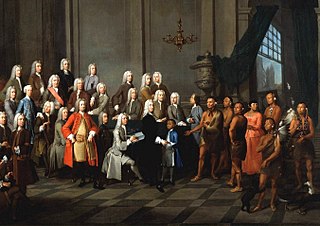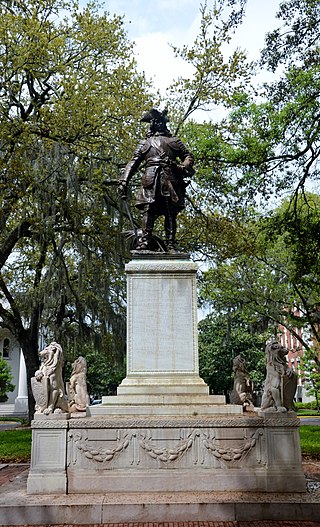
Darien is a city in and the county seat of McIntosh County, Georgia, United States. It lies on Georgia's coast at the mouth of the Altamaha River, approximately 50 miles south of Savannah, and is part of the Brunswick, Georgia metropolitan statistical area. It is the second-oldest planned city in Georgia and was originally called New Inverness. The population of Darien was 1,460 at the 2020 census, down from 1,975 in 2010.

Oglethorpe University is a private college in Brookhaven, Georgia, United States. It was chartered in 1835 and named in honor of General James Edward Oglethorpe, founder of the Colony of Georgia.

Benjamin Hawkins was an American planter, statesman and a U.S. Indian agent. He was a delegate to the Continental Congress and a United States Senator from North Carolina, having grown up among the planter elite. Appointed by George Washington in 1796 as one of three commissioners to the Creeks, in 1801 President Jefferson named him "principal agent for Indian affairs south of the Ohio [River]", and was principal Indian agent to the Creek Indians.

The Province of Georgia was one of the Southern Colonies in colonial-era British America. In 1775 it was the last of the Thirteen Colonies to support the American Revolution.

Ocmulgee Mounds National Historical Park in Macon, Georgia, United States preserves traces of over ten millennia of culture from the Native Americans of the Southeastern Woodlands. Its chief remains are major earthworks built before 1000 CE by the South Appalachian Mississippian culture These include the Great Temple and other ceremonial mounds, a burial mound, and defensive trenches. They represented highly skilled engineering techniques and soil knowledge, and the organization of many laborers. The site has evidence of "12,000 years of continuous human habitation." The 3,336-acre (13.50 km2) park is located on the east bank of the Ocmulgee River. Macon, Georgia developed around the site after the United States built Fort Benjamin Hawkins nearby in 1806 to support trading with Native Americans.

The Battle of Gully Hole Creek took place on July 18, 1742 between Spanish and British forces in the Province of Georgia, resulting in a victory for the British. Part of a much larger conflict, known as the War of Jenkins' Ear, the battle was for control of St. Simons Island, the British fortifications of Fort Frederica and Fort St. Simons, and the strategic sea routes and inland waters they controlled. After the victory, the Province of Georgia established undisputed claim to the island, which is now part of the U.S. state of Georgia. The better-known Battle of Bloody Marsh, a skirmish also won by the British, took place on the island the same day.

Tomochichi (to-mo-chi-chi') was the head chief of a Yamacraw town on the site of present-day Savannah, Georgia, in the 18th century. He gave land on Yamacraw Bluff to James Oglethorpe to build the city of Savannah. He remains a prominent historical figure of early Georgia history. As the principal mediator between the native population and the new British settlers during the first years of settlement, he contributed much to the establishment of peaceful relations between the two groups and to the ultimate success of Georgia.

The Yamacraw were a Native American tribe that emerged in the early 18th century, occupying parts of what became Georgia, specifically along the bluffs near the mouth of the Savannah River where it enters the Atlantic Ocean. They were made up of Lower Creek and Yamasee, and remained independent for about 20 years before integrating again with the main part of the Lower Creek people. This area was later developed as the city of Savannah.
The city of Savannah, Province of Georgia, was laid out in 1733, in what was colonial America, around four open squares, each surrounded by four residential ("tything") blocks and four civic ("trust") blocks. The layout of a square and eight surrounding blocks was known as a "ward." The original plan was part of a larger regional plan that included gardens, farms, and "out-lying villages." Once the four wards were developed in the mid-1730s, two additional wards were laid. Oglethorpe's agrarian balance was abandoned after the Georgia Trustee period. Additional squares were added during the late 18th and 19th centuries, and by 1851 there were 24 squares in the city. In the 20th century, three of the squares were demolished or altered beyond recognition, leaving 21. In 2010, one of the three "lost" squares, Ellis, was reclaimed, bringing the total to today's 22.

Ebenezer, also known as New Ebenezer, is a ghost town in Effingham County, Georgia, United States, near Ebenezer Creek, on the banks of the Savannah River. It was listed on the U.S. National Register of Historic Places as Ebenezer Townsite and Jerusalem Lutheran Church in 1974.
The city of Savannah, Georgia, the largest city and the county seat of Chatham County, Georgia, was established in 1733, and was the first colonial and state capital of Georgia. It is known as Georgia's first planned city and attracts millions of visitors, who enjoy the city's architecture and historic structures such as the birthplace of Juliette Gordon Low, the Telfair Academy of Arts and Sciences, the First African Baptist Church, Congregation Mickve Israel, and the Central of Georgia Railway roundhouse complex. Today, Savannah's downtown area is one of the largest National Historic Landmark Districts in the United States .[A]
Mary Musgrove was a leading figure in early Georgia history. She was the daughter of Edward Griffin, an English-born trader from Charles Town in the Province of Carolina, and a Muscogee Creek mother. Fluent in local Creek languages as well as English, Mary became an important intermediary between Muscogee Creek Natives and the early colonists. Musgrove carved out a life that merged both cultures, making a significant contribution to the development of colonial Georgia.

The Wormsloe Historic Site, originally known as Wormsloe Plantation, is a state historic site near Savannah, Georgia, in the southeastern United States. The site consists of 822 acres (3.33 km2) protecting part of what was once the Wormsloe Plantation, a large estate established by one of Georgia's colonial founders, Noble Jones. The site includes a picturesque 1.5 miles (2.4 km) oak avenue, the ruins of Jones' fortified house built of tabby, a museum, and a demonstration area interpreting colonial daily life.
Trustee Georgia is the name of the period covering the first twenty years of Georgia history, from 1732–1752, because during that time the English Province of Georgia was governed by a board of trustees. England's King George II, for whom the colony was named, signed a charter establishing the colony and creating its governing board on July 7, 1732. His action culminated a lengthy process. Tomochichi was a Native American that resides along the Savannah River that allowed Oglethorpe to settle on the Yamacraw Bluff.
The Trustees for the Establishment of the Colony of Georgia in America, or simply the Georgia Trustees, was a body organized by James Edward Oglethorpe and associates following parliamentary investigations into prison conditions in Britain. After being granted a royal charter in 1732, Oglethorpe led the first group of colonists to the new colony, arriving there in February, 1733. The trustees governed Georgia, one of the Thirteen Colonies, from its founding until 1752, a period known as Trustee Georgia.

James Edward Oglethorpe was a British soldier, Member of Parliament, and philanthropist, and the founder of the Province of Georgia in what was then colonial-era British America. As a social reformer, he hoped to resettle Britain's "worthy poor" in the New World, initially focusing on those in debtors' prisons.

Lebanon Plantation is a state historic site located at 5745 Ogeechee Road in Savannah, Georgia. The site is over 500 acres (2.0 km2) consisting of a large estate granted to James Deveaux in 1756, and was named for the many cedar trees on the property. An additional 500 acres were granted to Phillip Delegal in 1758 and eventually became part of the plantation. The site was purchased by Joseph Habersham in 1802. Habersham sold it in 1804 to George W. Anderson who built the main house that was rebuilt and added on to after the American Civil War. Anderson's son, George Wayne Anderson, JR Commanded Fort McAllister in the Civil War, and after the fort fell, Lebanon became his prison and the headquarters of the Fifteenth Army Corps of the US Army.

The James Oglethorpe Monument is a public monument in Chippewa Square, Savannah, Georgia, United States. The monument honors James Oglethorpe, the founder of the Province of Georgia, who established the city of Savannah in 1733. Efforts towards the monument's erection began in 1901 and were led by members of several patriotic groups in the city, who secured government funding for the monument. The monument consists of a bronze statue of Oglethorpe, designed by Daniel Chester French, atop a large granite pedestal designed by Henry Bacon. It was dedicated in 1910, in a ceremony that attracted several thousand spectators and was attended by several notable government officials.
Abraham Minis was a European immigrant to the newly settled colony of Savannah, Province of Georgia, in 1733. Despite their not knowing if they would be received, General James Oglethorpe, founder of the Savannah colony, allowed Minis and his family entry and granted them land. Their descendants have lived in Savannah ever since.

Audience Given by the Trustees of Georgia to a Delegation of Creek Indians is an oil-on-canvas group portrait created by English painter William Verelst (1704–1752). It was painted in London in 1734 or 1735. A bequest from Henry Francis du Pont, the painting is held in the permanent collection of the Winterthur Museum, Garden and Library. The painting depicts a Creek Yamacraw delegation, including Tomochichi, meeting with the governing body of the English Province of Georgia.














